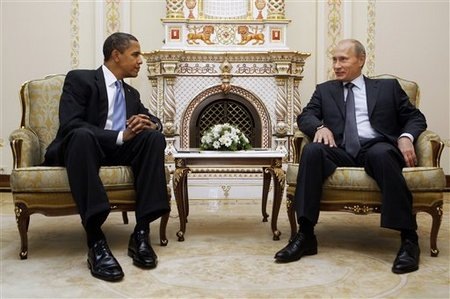
Russian Prime Minister Vladimir Putin, who emerged victorious in this year’s elections, was sworn into office in the Kremlin on May 7. Putin has always been known as a “tough guy,” and the “return of the king” has left greater room for speculation on the relationship between Russia and the West. In particular, the impasse between the U.S. and Russia, centered on the issue of the missile shield, may be even harder to break.
The U.S. and Russia first locked horns on the European missile shield during the previous Bush administration. After taking office, President Barack Obama revised the Bush-era plans, promising to use shorter-range interceptor missiles in an attempt to ease tension between the two nations. However, at the Lisbon Summit in November 2010, NATO leaders resolved to build a missile shield blanketing Europe, making the anti-missile systems deployed in Europe by America a central component, and also invited Russian cooperation. But Russia was of the opinion that its strategic security was threatened by the missile shield. The two sides have since held many talks on the issue, but have continually been unable to reach a consensus.
On May 3 and 4, an international conference labeled the “Missile Defense Factor in Forming a New Security Space” convened in Moscow. The conference was proposed and organized by Russia, with more than 200 military representatives and experts attending from almost 50 nations, including members of NATO, Russia, China, South Korea, Japan and countries within the Commonwealth of Independent States and the Collective Security Treaty Organization, as well as international organizations.
Experts suggest that by hosting the conference, Russia hoped to use direct exchanges with military experts from NATO countries to explore, from the specialists’ perspectives, the harm done to the global nuclear strategic balance by NATO’s unilateral deployment of missile defense systems in Europe. However, at the conference, officials from Russia and the NATO member states merely expounded upon their own opinions regarding NATO’s objectives in establishing anti-missile systems, the feasibility of Russia-NATO cooperation on the missile shield issue, the effect of the missile shield on bilateral relations, etc., with the divide remaining as clear as before and neither side willing to make concessions.
Leaks reveal that NATO’s construction of the European missile shield will be divided into four stages, with the stages to be completed by the end of this year, then the end of 2015, 2018 and 2020, respectively. The first stage will see the deployment of ship-based “Aegis” radar and interceptor missiles, as well as the opening of a radar station with enhanced capabilities in Turkey, followed by the deployment of radar and interceptor missiles in the Eastern European states of Romania and Poland. U.S. officials claim that the deployment of anti-missile systems in Europe is meant to counter the threat from Iranian and North Korean cruise missiles, that it is “not and will not be directed against Russia” and that Russian ICBMs are “too fast and too complicated” for NATO anti-missile systems to intercept. Russian Chief of General Staff Nikolai Makarov said that the alleged Iranian and North Korean missile threat was a fabrication and that although those countries had plans to develop intermediate and short-range missiles, it would be extremely difficult for them to develop and manufacture ICBMs, especially while international sanctions continue. Makarov believes that the third and fourth stages of the NATO missile shield give Russia cause to worry because at that time “the capability to intercept Russian intercontinental ballistic missiles will be real.”
Really, NATO’s deployment of weapons in Russia’s backyard makes it quite difficult for Russia to believe claims that it is not the target. Russia has requested in the past that the U.S. issue a written guarantee that NATO’s European missile shield will not be directed against Russia, but was refused. At the conference, Russian dialogue was sharp. Makarov warned that if the U.S. government continues to move forward with the deployment of missile defense systems in Europe, Russia will “preemptively” strike NATO’s Eastern Europe anti-missile installations. In fact, President Medvedev warned last year that Russia will make military reprisals if it cannot reach an agreement with the U.S. and NATO. Russia’s Deputy Premier Dmitry Rogozin told Russian media on May 4 that Russia will not allow any country in the world to create a missile defense system which might upset the strategic balance of power. According to reports, Russia recently deployed a new radar station in the “enclave” of Kaliningrad, near the Polish border, that can monitor missile launches in Europe and the North Atlantic. Makarov also stated that Russia has the option of deploying short-range “Iskander” missiles in Kaliningrad.
As to the extreme differences in opinion between Russia and the U.S. on the missile shield issue, some within the Russian media believe that it was unrealistic to hope to resolve the extremely complex missile shield issue through a single international conference. Analysts indicate that without a breakthrough in negotiations between Russia, NATO and the U.S., Russia will be forced to adopt strong retaliatory measures, causing a serious blow to U.S.-Russia and Russia-NATO relations, and even global stability.

Leave a Reply
You must be logged in to post a comment.